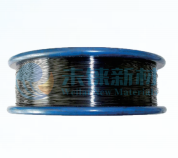Zhuzhou Weilai New Materials Techonology Co., Ltd
Tel:0731-22160654
Mobile:
+8615773363955(Mr. Duan)
+8615200507438(Ms.Zhang)
E-mail:sales@rheniumcn.com
Fax:0731-22160654
Address:No.103, Building 2, Tiantai
Jingu Industry Park, Tian Yuan
District,Zhuzhou,Hunan,China
The production of tungsten wire mostly uses ammonium paratungstate (APT) as the raw material. The general process involves roasting ammonium paratungstate in air at around 500 ℃ to form tungsten trioxide, or slightly reducing it to blue tungsten oxide in hydrogen at around 450 ℃. The production of rhenium tungsten filament for incandescent lamps requires the addition of a small amount of potassium oxide, silicon oxide, and aluminum oxide to tungsten trioxide or blue tungsten oxide, with a total amount of no more than 1%. This is the tungsten filament doping process invented by Baz in 1922. The doped tungsten oxide is reduced to metallic tungsten powder using hydrogen gas. The reduction process is generally divided into two steps: the first step is to reduce to tungsten dioxide (brown tungsten oxide) at around 630 ℃, and the second step is to reduce to metallic tungsten powder at around 820 ℃.

The purpose of two-step reduction is to fully utilize the added potassium and control the particle size of the powder. The doped tungsten powder obtained in this way is then pressed into slender square bars in a special mold. The square strip is electrified in hydrogen gas and sintered using self resistance heating (with a temperature of around 3000 ℃). After sintering, the density of the tungsten strip can reach over 85% of the theoretical value. This type of tungsten rod can be processed into tungsten rods with a diameter of about 3mm by rotary forging, and then further processed into various tungsten wires of different thicknesses by mold drawing. For example, the tungsten wire diameter used for 220V and 15W incandescent lamps is about 15µ m. The tungsten wire diameter used for the 10000W brominated tungsten lamp is approximately 1.25mm. A thinner tungsten wire, such as a 220V, 10W incandescent lamp, has a diameter of approximately 12µ m. Electrolytic corrosion method should be used for production.
When the diameter of tungsten wire reaches the micrometer level, it is difficult to accurately measure its diameter using conventional calipers. Therefore, internationally, tungsten wires with a diameter of less than 0.2mm are usually represented by their weight cut into 200mm segments to indicate the thickness of the wire. For example, the diameter of rhenium tungsten wire for 15W incandescent lamps mentioned above can be represented by 0.679mg/200mm.
Address:
No.103, Building 2, Tiantai Jingu Industry Park,
Tian Yuan District,Zhuzhou, Hunan, China.